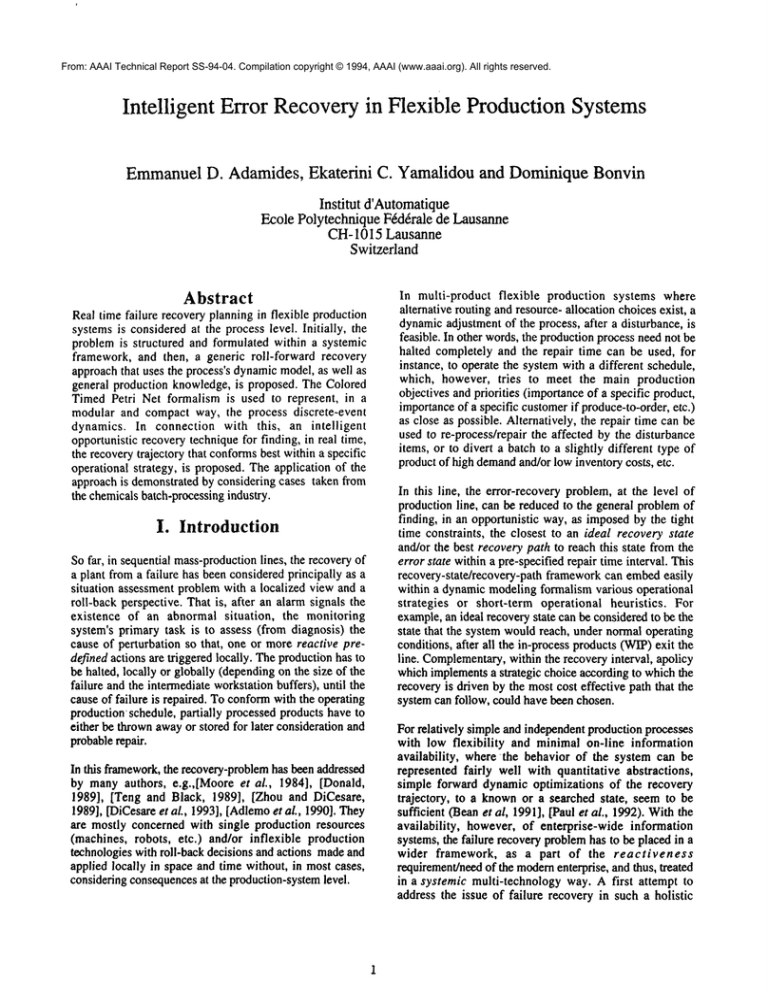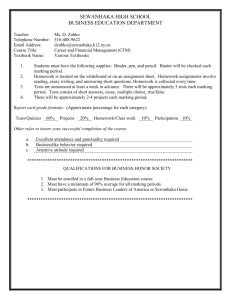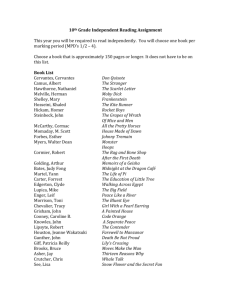
From: AAAI Technical Report SS-94-04. Compilation copyright © 1994, AAAI (www.aaai.org). All rights reserved.
Intelligent Error Recoveryin Flexible Production Systems
EmmanuelD. Adamides, Ekaterini C. Yamalidou and Dominique Bonvin
Institut d’Automatique
EcolePolytechnique
F&ltralede Lausanne
CH-1015 Lausanne
Switzerland
Abstract
Real time failure recovery planning in flexible production
systems is considered at the process level. Initially, the
problem is structured and formulated within a systemic
framework, and then, a generic roll-forward recovery
approach that uses the process’s dynamicmodel, as well as
general production knowledge, is proposed. The Colored
Timed Petri Net formalism is used to represent, in a
modular and compact way, the process discrete-event
dynamics. In connection with this, an intelligent
opportunistic recovery technique for finding, in real time,
the recovery trajectory that conformsbest within a specific
operational strategy, is proposed. The application of the
approach is demonstrated by considering cases taken from
the chemicals batch-processingindustry.
I. Introduction
So far, in sequential mass-productionlines, the recovery of
a plant from a failure has been considered principally as a
situation assessment problem with a localized view and a
roll-back perspective. That is, after an alarm signals the
existence of an abnormal situation,
the monitoring
system’s primary task is to assess (from diagnosis) the
cause of perturbation so that, one or more reactive predefined actions are triggered locally. The production has to
be halted, locally or globally (dependingon the size of the
failure and the intermediate workstation buffers), until the
cause of failure is repaired. To conformwith the operating
production schedule, partially processed products have to
either be thrownawayor stored for later consideration and
probablerepair.
In this framework,the recovery-problemhas been addressed
by many authors, e.g.,[Moore et al., 1984], [Donald,
1989], [Teng and Black, 1989], [Zhou and DiCesare,
1989], [DiCesare et aL, 1993], [Adlemoet aL, 1990]. They
are mostly concerned with single production resources
(machines, robots, etc.) and/or inflexible production
technologies with roll-back decisions and actions madeand
applied locally in space and time without, in most cases,
considering consequencesat the production-systemlevel.
In multi-product flexible production systems where
alternative routing and resource- allocation choices exist, a
dynamicadjustment of the process, after a disturbance, is
feasible. In other words, the production process need not be
halted completely and the repair time can be used, for
instance, to operate the system with a different schedule,
which, however, tries to meet the main production
objectives and priorities (importanceof a specific product,
importanceof a specific customerif produce-to-order, etc.)
as close as possible. Alternatively, the repair time can be
used to re-process/repair the affected by the disturbance
items, or to divert a batch to a slightly different type of
product of high demandand/or low inventory costs, etc.
In this line, the error-recovery problem, at the level of
production line, can be reduced to the general problem of
finding, in an opportunistic way, as imposedby the tight
time constraints, the closest to an ideal recovery state
and/or the best recovery path to reach this state from the
error state within a pre-specified repair time interval. This
recovery-state/recovery-path frameworkcan embedeasily
within a dynamic modeling formalism various operational
strategies or short-term operational heuristics.
For
example,an ideal recovery state can be considered to be the
state that the system wouldreach, under normal operating
conditions, after all the in-process products (WIP)exit the
line. Complementary,within the recovery interval, apolicy
which implementsa strategic choice according to which the
recovery is driven by the most cost effective path that the
system can follow, could have been chosen.
For relatively simple and independent production processes
with low flexibility
and minimal on-line information
availability,
where the behavior of the system can be
represented fairly well with quantitative abstractions,
simple forward dynamic optimizations of the recovery
trajectory, to a knownor a searched state, seem to be
sufficient (Beanet al, 1991], [Paul et al., 1992). Withthe
availability,
however, of enterprise-wide information
systems, the failure recovery problemhas to be placed in a
wider framework, as a part of the reactiveness
requirement/needof the modernenterprise, and thus, treated
in a systemic multi-technology way. A first attempt to
address the issue of failure recovery in such a holistic
approach, in a Distributed Artificial
Intelligence
framework, has been presented in [Adamides and Bonvin,
1993].
to the general production objectives and requirements/
constraints as given in the nominal schedule, the product
database,etc.
In this paper, we propose a general dynamic recovery
schemefor flexible production systems which is based on
the above view of the problem. More specifically, the
ColoredPetri net (CPN)formalism is used to represent the
system’s dynamic behavior under both normal and
abnormal operating conditions. To be able to exercise
control externally, in synchrony with a global clock, an
external time scale is introduced, In the CPNcontext, the
recovery problem becomes a kind of optimal marking
control problem, in which, it is required to determine the
transition-firing sequence that will bring the net into a
desired final marking at minimumcost. This implies that
the behavior of the CPNis modified in a controlled way.
The application of the proposed error-recovery approach is
demonstratedin the recovery of a batch-processing flexible
productionline. Various recoverystrategies are considered.
II. Externally controlled
The Petri net, in its various types and forms, has been a
popular functional and dynamic modeling formalism for
manufacturing control applications at various levels. The
mergingof Petri net modelingand heuristic search has been
proposed for the scheduling of simple flexible
manufacturing systems (Lee and DiCesare, 1992).
simple timed Place-Transition net (P/T-net) has been used
to generate the states in the search for a final "allscheduled" state. Somevery simple heuristics functions to
guide the search efficiently have also been tried. The
optimal schedule is obtained as the minimum-costsequence
of transition firings.
A heuristic-search
algorithm evaluates every state
(marking) as a potential goal state by considering its
relative "goodness" and/or its reaching-path cost. Every
state is examined in accordance with a "weightedresemblance" criterion which, indirectly, implements
priority heuristics associated to the various systemobjects
(products, resources, etc.) The search operators (occurrence
elements of the CPN)are ordered according to proximity
measuresand heuristics. Hence,on-line process and product
information can be used to adjust dynamicallythe heuristic
parameters. Figure i showsthe functional architecture of
the approachpresented in this paper.
T
I
Recoveryalgorithm
I
Heuristic search algorithms guide the search according to
heuristic metrics that either evaluate states in relation to a
target state to provide (order) dynamicallythe "next-state"
operators. The Petri net is a modelingformalism that can
represent the dynamicbehavior of the production system in
relation to the discrete events that take place in the shop
floor. Therefore, comparedto quantitative abstractions in
the form of flow equations or to pure knowledge-based
techniques wheretemporal behavior of parallel processes is
difficult to be managed,it can represent better the behavior
of a dynamicprocess. Furthermore, the Colored Petri net
(CPN) (Jensen, 1992) offers a compact modeling
frameworkwhich has an inherit hierarchical representation
of process detail and, thus, it can be "unfolded"selectively
to reveal behavioral details and properties of interest
without needing to be considered it in its whole. This
inherit hierarchy, together with its structure, offer a very
attractive basis for the development of an intelligent
recovery approach which essentially uses the same (normal
operation) process model.
¯
/
ColorPetri Net modelof i
real productionsystem
I\
I
~
Rulebase
(systemand
product(s)
specific)
I
Operatingstrategy/
heuristicrole
CPN
The CPNhas been defined formally by Jensen (Jensen,
1992). In an informal way, a CPNis a PNwith tokens of
different colors (types) and functions (expressions)
associated with its arcs. The arc expressions translate the
relation between the color associated with and chosen to
fire this transition (firing color), and the colors associated
with the tokens in the correspondingplace (token color).
guard of a transition is a Boolean expression which must
be evaluated to true before the transition can occur~fire. In
addition, every transition has a number of variables
associated with it (variables from the incoming arc
expressions). Before the transition fires, these variables
have to be boundto colors of the correspondingtypes. This
meansthat a transition of a CPNcan fire in manydifferent
inf¢.nmoe
ellgillc
Figure 1: The recovery system’s architecture
The inference engine moduleis a rule interpreter whose
outcome, after forward chaining, is the best recovery
strategy/heuristic for the particular situation. The rules are
taken from the rule base and they relate the system’s state,
as given by the CPNmarking, to the causes of failures and
2
waysaccordingto its binding, its guardand the specific net
marking.A pair, wherethe first element is a transition and
the second a binding of that transition, is called an
occurrence element. A transition maybe enabled for many
different bindings at a particular time instance and many
occurrence elements may be enabled at the same time. A
step includes all the enabledoccurrenceelementsi.e. it is a
non-empty and finite multi-set over the set off all net
bindings.
In order to control the firing of the CPN, one has to
control/restrict the values of the bindings of the net’s
transitions and/or to adjust the guards associated with the
transition. The control can be in a hierarchical manner,i.e.,
if a transition, for somereason (e.g. time), is not enabled
at all, it is not considered, whereasif it is, the various
firing possibilities can be examinedand graded according to
static or dynamicoperational criteria imposedby strategic
choices. Concurrently enabled transitions have to be
checkedfor possible conflicts. In line with this, the search
for the best recovery state (CPNmarking) takes place
manipulating transition bindings and guards using static,
and dynamically generated knowledgeby the problem and
its solution process, respectively.
In addition, to control the systemin a deterministic way,
an external time scale has to be introduced. The external
time scale synchronizes the evolution of the system to
discrete time steps by restricting the transitions of the Petri
net to fire, if enabled, at specific discrete time instances.
The inclusion of time information in the model helps
decision making in the cases where the production
processes are structured
and the timing almost
deterministic. A global system clock is introduced and, in
addition to its color attribute, every token has a time stamp
(Jensen 1992) attached to it. For our modelingframework,
the time stampis a pair (a,13), wherea is the earliest time
that the token can be removedby a binding element and 15
is the maximumtime allowed for a token to stay at a
place. Both elements refer directly to the global time scale
whose values increase continuously
without reinitialization. To calculate the time stamps of the tokens
from the production recipe, time clauses are assigned to the
output arcs of every transition. A time clause specifies for
every color the minimumand maximumdelay values that
are added to the current reading of the global clock to
producethe pair (a,~).
III. Intelligent search with Colored
Petri nets
In order to accomplish the heuristic search on the marking
space of CPN, in a hierarchical manner, the operator
ordering function O is defined. In its generic form, it is
defined as a map of CPNmarkings onto an ordered set of
occurrence elements, i.e. into a list of ordered CPNsteps
(Jensen 1992)
3
O : Mxx Mid x Sx --> S’x
where Sx is the order of the step before marking Mx, and
S’x is the order after markingMxhas been reached. Midis
the target ideal recoverymarking.
Within the context of the domainconsidered in this paper,
O can be applied in connection with the proximity measure
discussed below, i.e., operators are ordered accordingto the
results of the evaluation of the (weighted) proximity
measure. In addition to ordering, the elimination of some
¯ of the step’s elements is possible. Occurrenceelements are
always ordered with primary key the heaviest-weighted
attribute.
For the system to be able to search for the "best" state
and/or the best path to this state, a relative evaluation
measurefor each state and every path has to be defined. The
two metrics (resemblance and energy/cost) can be used
evaluate the states/markings reached. In the recovery
algorithm given in the next section, states are evaluated
only in relation to the proximity measure.
A. The proximity/goal
attainment
metric
In evaluating the resemblanceof a state in relation to the
ideal state, different colors in the sameplace havedifferent
degrees of importance as imposedby the recovery strategy
employed. Hence, the proximity or deviation of a state
to/from the goal state is evaluated by a function of the
weighted difference of the two states. The weights are
specific to the recoverystrategy.
Since the marking m of a CPNis the set of markings of
the individual places
Pr[g(i)-g(y)] = {weighted difference in numberof tokens
for everynet place}
= [WplI (Wcl*A(el) + We2*A(c2)...
WP12(Wel*A(cl) Wc2*A(c2) .. . ) ..
WPly (Wcl*A(el) + Wc2*A(c2) ...
where Wpli is the weight of place Pli, Wci is the
weight of color ci, and A(cl) is the difference
tokens of color ei between the state
being
examined and the goal state.
By quantifying the difference
between the ideal
state/marking and an arbitrary marking of the CPN, a
degree of relaxation of optimality (100%resemblance),
can be defined as
l el = I Pr~i)-g(y)]
It must be noted that recovery algorithms that guide the
search using the above cost measureonly, can be developed
and used in cases where the recovery cost per se is the
primary minimization factor, a recovery target state is
knownand its reachability is guaranteed. In this case, the
problem can be formulated as a dynamic program whose
solution for large systems can be obtained using
hierarchical decompositiontechniques. In reality, however,
the existence of such conditions is a rare case.
IV. A proximity function-based
recovery algorithm
Taking into account the discussion in the previous section,
the proposed generic algorithm to be used for the recovery
of failed processes is presented belowin a hierarchical and
modular way:
ALGORITHMRecovery
Until a markingthat satisfies the termination condition is
found do
1. Fire enabled transitions
and obtain new
marking;
2. Examine marking and sort operators;
end.
ALGORITHM
Fire
enabled
transitions
and obtain
lm maxkt
1. For every CPNtransition in the current markingdo
1.1 Deducefrom high-level recovery plan and markings of
input places if transition has to be consideredat this step;
1.2 If it need not be considered then exit
else
1.2.1 Use sorted occurrence elements list to bind
transitions with the most promising bindings
1.2.2 Use external heuristics to resolve any firing conflicts;
1.2.3 Fire transitions and composenew marking;
end if; end for;
ALGORITHM Examine
markin2
and sort
operator~
1. With the current marking do
1.1 Check if the marking satisfies
the termination
condition;
1.2 Calculate cost of arriving at the marking from the
initial marking;
1.3 Calculate measure of proximity to the ideal target
marking;
1.4 (Re)order occurrence elements in accordance with the
results of the measureof proximity;
end;
The execution of the above algorithm(s) requires the,
specification of the occurrence-elementsordering function,
whichis either pre-specified or is given interactively by an
operator. Recoverystrategies and the information structures
required to accomplish them are discussed in detail in
[Adamidesand Bonvin, 1993]. The termination condition
of the Recovery level mayhave various forms, including
step count, relaxation of optimality measure,etc.
V. Example of application of the
proposed algorithm
To demonstrate the development and use of the proposed
recovery method, a multi-purpose chemical batch plant
with five units and three products is considered. Batch
plants consist of a groupof identical or different processing
units that can process several products at the same time.
The reference system consists of five reactors sized at
1000It., 20001t., 30001t., 40001t. and 5000It. A single
buffer having a capacity of 5000It. also exists. Three
products are producedand they are identified by A, B and C.
Each of the units is equally capable of performing any of
the tasks. Mergingof batches of different products in any
resource of the system is notailowed. The size of the
batches entering the system is alwaysa multiple of 500 It.
Since the recipe for A and B requires a doubling of the
batch size in the second stage, then the only batches of A
and B that mayenter the system from the supply feed are
the 500, 1000, 1500, 2000 and 2500 it. The batches of C
require only one processing stage, therefore, they are sized
at 1000, 2000, 3000, 4000 and 5000 It. Product A requires
3 time units in its first stage and 5 time units in the
second. Product B requires 4 and 3 time units, respectively.
Finally, the single processing step of product C takes 6
time units.
The structure of the CPNwhich models the "uncontrolled"
process for the reference system is shownin figure 2 Arc
expressions and quards are not shown, but they are defined
so that the net modelsthe above operational policy. Places
pl and p2 act as resource pools supplying resources to the
process, p3, p4, p5 and p6 form the general set of states of
the processing sequences for all the products, p7 and p8
signal errors in the system, whereasp9 is a repository for
the tokens that represent failed reactors. Tokens remain
there whilst the correspondingreactors are being repaired.
Theguardsof the transitions ensure that the size of the unit
assigned to a batch should be greater or at least equal to the
size of the batch.
The occurrence of errors in the system is manifested by the
presence of a tokens in places p7 and/or p8. Transitions t5
and t9 are fired by the physical cause of the errors. A failed
batch from the first production stage can be recycled (t7)
it can be taken out of the system (t6). The colored token
representing the failed reactor enters p9. Failure during the
second stage implies the immediatedismissal of the failed
batch. The buffer is assumedto form the hard core of the
system, i.e. it is a completelyreliable device. However,its
contents can be discharged.
Target state: Place p6 must contain as muchas possible
from all products. There is no product-importance
weighting.
/
J
//
//\ I II
\/
//
\
’~’
N
--\
¢
v
Figure 2." CPNmodel of the production process
Weassumethat the failure happensat a systemstate:
(RI, IB, 3, a), (R2, 2A, 2, a), (R3, O, 0, -), (R4,
b), (R5, 5C, 0. a), (B,
whereR! representsunit (reactor) I, the secondelement
the parenthesis denotes the batch, 0,1,2,3.. denotes the
time the batch(type andquantity) has already spent in the
specific reactoranda andb are the processingstages. In the
first recovery case presented below, we assumethat the
failed batch can moveto the next processingstage, whereas
in the second, it needsre-processing.Thebuffer is assumed
to consist of 10b (b = 5001t) units and, in all cases, the
decision to re-process the failed batchis assumedto have
already been made.
Constraint: Recoveryinterval is 20 time units. If it not
possible to recover within this time interval failed batch
will haveto be thrown.
Basic operator ordering rule:
highest priority.
Failed batch has
Figure 4 shows the recovery trace for this case. At time
step t=7, the error batchis pouredinto the buffer since it
requires two stages of processing. In the CPNmodel, t3
fires to emptythe buffer, then t2 is boundto color A and
fires. Immediatelyafter, t3 is boundto the samecolor, as
far as productis concerned,but the tokenreturns to place
p3 to signal that stage I processingagain.
The application of the proposed roll-forward recovery
approachto the cases described abovehas been madein our
prototyping set-up consisting of the CPNdevelopmentand
simulation environment SPECS, provided by Landis &
Gyr Betriebs AG, and the hybrid AI workbenchBABYLON
[Cristaller et al., 1992]. In this set-up, different to the
above presented strategies can be very easily implemented
without manychanges.
p1
p2
R3
p4
1E31:~1
IObA
2AR2(e)rror
5CR5
(t3)
IBR1F)
7bA
2AR2e
5CR5
3b
<<<<
p3
<<<<
3b
R4
<<<<
IBRI(T)
ZAR2e
<<<<
4
)0
pS
p6
time
2AR4
(t=l)
~AR4
3AR3
<<<<
<<<<
7hA
3AR3(T)
(t2,ta,t4)
3bA
4AR4
5A
5C
4AR4
)AR3
GA
5C
IAR4
13AR3
5A
5C
4AR4
3AR3
2BR5
5A
5C
(t=2)
<<<<
(t=5)
ScR~r)
CASE1: Product B has very tight due dates and very high
WIPcosts. Product in failed reactor has been processed
enough as to be considered as having completed the
correspondingprocessingstage.
1BRICF
)
2AR2
(t=6)
(t3)
lOb
1:15
18Rl{T)
2AR2e
~
Target state: Place p6 must contain token 2B.
8b
R5
Rt
2AR2e
268
Constraint: Recoveryinterval is 15 time units.
I 0b
Rt
2AR2e
21
Basic operator ordering rule: B has higher priority
in any case overother products
6b
R1
R~
4bA
(t=7)
(t=o)
(t2)
(t3)
(t.t)}
(t2)
(t=10)
4AR4(T)
3AR3
2BR5
SA
5C
3AR3(T)
PA
(t4)
The recoverytrace for this case is shownin figure 3. The
applicationof the priority rule can seen in time step t=7,
whereemptyingthe buffer to advanceprocessing of product
B is preferredfrompouringa type A productinto the buffer
(transition t3 fires to emptythe buffer andthen t2 is bound
with the color B).
CASE2: Failed batch needs re-processing at stage 1.
6b
~
4bA
R~
(t.11)
2BRSfT) SC
PA
(t3,t4)
I Ob
I~1
3
O
(tin12)
4AR4
12A
2B
GC
FI5
Figure3: Recoverytrace for case I
p!
p2
?b
R3
p6
1BRI(T)
2AR2(e)
3hA
1BRI~T}
2AR2(e)
,lO
(t3}
:
IBRI~r)
4bA
1BRt(T)
4AR5
4hA
8b
R1
4AR5
2bB
8b
R1
PA
4AR5(T)
lob
4ARS(T)
4AR4
5A
5C
4Aft4
3AR3
5A
5(:;
4AR4
3AR3
5A
5(:;
(t3)
lOb
4AR4
3AR3
5A
5C
(t2)
4AR4(T)
3AR3
5A
5C
(t4)
J2bB
3AR3(T)
:gA
5C
(t.ll)
(t3,t4)
~
12A
5C
2BR4
12A
5C
(t3)
O
~
/
<<<<
10b
RI
R3
R4
R5
<<<<
~
<<<<
~
(t2)
(t.11}
(t=13)
R1
t0b
R1
(t,=o)
[Beanet al., 1991], J.C. Bean, J.R. Birgle, J. Mittenthall,
and C.E. Noon,"Matchup Scheduling with Multiple
Resources, Release Dates and Disruptions", Operations
Research, 39(3):470-483, 1991.
[Cristaller et al., 1992], T. Christaller, F. di Premio, U.
Schnepf and A. Voss (edited by), "The AI Workbench
BABYLON",
Academic Press, 1992.
(t=12)
2BR4
(t2)
8bA
[Adlemo et al., 1990], A. Adlemo,S.-A. Andr6asson, T.
Andr6asson, and C. Carlsson, "Achieving Fault Tolerance
in Factory Automation Systems by Dynamic Configuration", Proceedingsof the First International Conferenceon
Systems Integration, Morristown, NJ, pages 396-402.
(t=7)
(t2)
6b
R5
Time
[DiCesare et al., 1993], F. DiCesare, G. Goldbogen, D.
Feicht, and D.Y. Lee, "Extending Error Recovery
Capability in Manufacturing by Machine Reasoning",
IEEE Trans. Systems, Manand Cybernetics, 23(1): 221228, 1993.
(t.14)
2BR4(T)
3AR3
5AR5
<<<<
O
12A
5C
<<<<
20A
2B
5C
Figure 4: Recoverytrace for case 2
[Donald 1989], B.R. Donald, "Error Detection and
Recoveryin Robotics, Lecture Notes in ComputerScience,
No. 336, Springer-Verlag, 1989.
[Jensen, 1992], K. Jensen, "Coloured Petri Nets. Basic
Concepts, Analysis Methods and Practical Use. Volume
I", EATCS Monographs on Theoretical
Computer
Science, Springer-Verlag, 1992.
VI. Conclusions
Wehave presented a systems approach to failure recovery
in flexible production systems. Wehave shown how the
problem of roll-forward error recovery at the productionsystem level can be rationalized and howthe Colored Petri
Net formalism can be used to represent, in a compactand
modular way, the system’s dynamic behavior, during the
recovery phase, as in normal operation. In addition, we
have shown how the decision making process can be
simplified by structuring the decision space by using
process knowledge. Finally, we have shown how the
controlled firing of the CPN,in connection with various
effectiveness measures, can implementdifferent recovery
policies The separation of the recovery strategy from the
systems dynamics, implies that various policies deduced
from the system’s state, the global production strategy and
the available information can be applied without any need
of changing the system model.
References
[Adamides and Bonvin, 1993], E.D. Adamides, and D.
Bonvin, "Error Recovery of Flexible Manufacturing
Systems Through Cooperation of Distributed Intelligent
Agents", Proc. of KNOWHSEM
’93 pages 227-238,
Budapest, April 1993.
[Lee and DiCesare, 1992], D.Y. Lee and F. DiCesare,
"FMSScheduling Using Petri Nets and Heuristic Search",,
Proc. of the 1992 IEEE Int. Conf. on Robotics and
Automation, Nice, France, pages 1057-1062, 1992.
[Moore et al., 1984], R.L. Moore, L.B. Hawkinson, C.G.
Knickerbocker and L.M. Churchman, "A Real-Time Expert
System for Process Control", Proceedings of the First
Conference on Artificial Intelligence Applications, pages
569-574, 1984.
[Paul et al., 1992], C.J. Paul, L.E. Holloway, D. Yan,
J.K. Stronsnider, and B.H. Krogh, "AnIntelligent Reactive
Monitoring and Scheduling System", IEEE Control
Systems Magazine, pages 78-85, June 1992.
[Teng and Black, 1989], S.-H. Teng and J.T. Black, "An
Expert System for Manufacturing Cell Control",
Computersand Industrial Engineering, (17)1-4:, 18-23,
1989.
[Zhou and DiCesare, 1989], M.C. Zhou and F. DiCesare,
"Adaptive Design of Petri Net Controllers for Error
Recovery in Automated Manufacturing Systems", IEEE
Trans. on Systems, Manand Cybernetics, (19)5:963-973,
1989.






